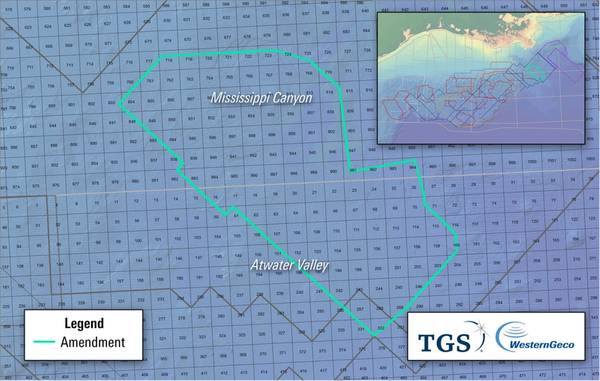
TGS and Schlumberger’s geophysical services product line WesternGeco will work together to develop opportunities to co-invest in additional multiclient ocean-bottom node projects in the deepwater U.S. Gulf of Mexico under a new collaboration agreement announced Wednesday.
This collaboration includes the previously-announced 2,350 square kilometer Amendment Phase 1 project in the Mississippi Canyon and Atwater Valley protraction areas. Supported by industry prefunding, Amendment Phase 1 commenced in early 2019 and data acquisition is expected to complete in the third quarter of 2019.
Both TGS and WesternGeco have extensive, high-quality multiclient libraries of seismic and other geoscience data in the U.S Gulf of Mexico. The combination of ocean-bottom node data, the associated velocity model improvement, full-waveform inversion and other data processing techniques will significantly improve imaging of complex subsalt structures. By collaborating and using the available underlying data, WesternGeco and TGS will be able to produce a higher-quality product for clients than would otherwise be available over the areas of interest.
Exploration and production companies are increasingly looking to ocean-bottom nodes, combined with advanced processing, as the next-generation technology to support both exploration and development activities in the Gulf of Mexico. Ocean-bottom node technology has traditionally been focused on development and time-lapse 4D seismic applications, but multiclient node projects will also have significant impact on near-field and greenfield activities.
“TGS and WesternGeco have a strong track record of investing together, using the latest technology so that our clients can benefit from large-scale, high-quality data in the U.S. Gulf of Mexico. Both companies are at the forefront of ocean-bottom node technology with Amendment Phase 1 being the world’s first large-scale, multiclient sparse node program. We are working closely with our clients to plan future phases and are excited by the potential growth in exploration and production activity that this could drive in the U.S Gulf of Mexico and beyond,” said Kristian Johansen, CEO, TGS.
Maurice Nessim, president, WesternGeco, added, "In line with our asset-light strategy and global technology leadership, we are looking at opportunities to deploy and accelerate the use of advanced technologies, including ocean-bottom node technology. Our goal is to help our clients mitigate subsurface risks and accelerate their exploration and development programs. WesternGeco and TGS are leading the industry in the application of ocean-bottom nodes on multiclient seismic projects. Our geophysical, geological and technology expertise position us well for this next phase of activity in the U.S. Gulf of Mexico.”



